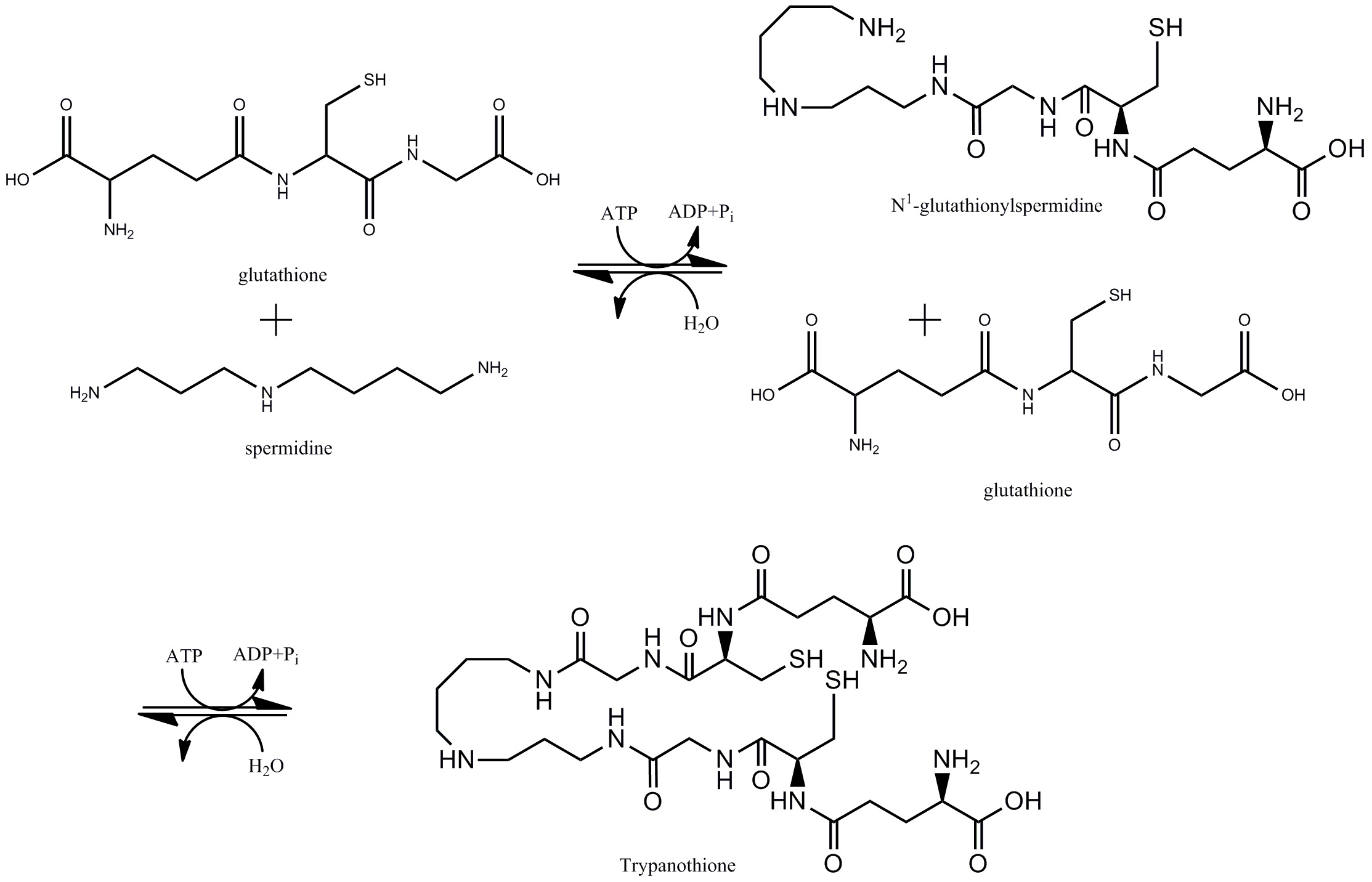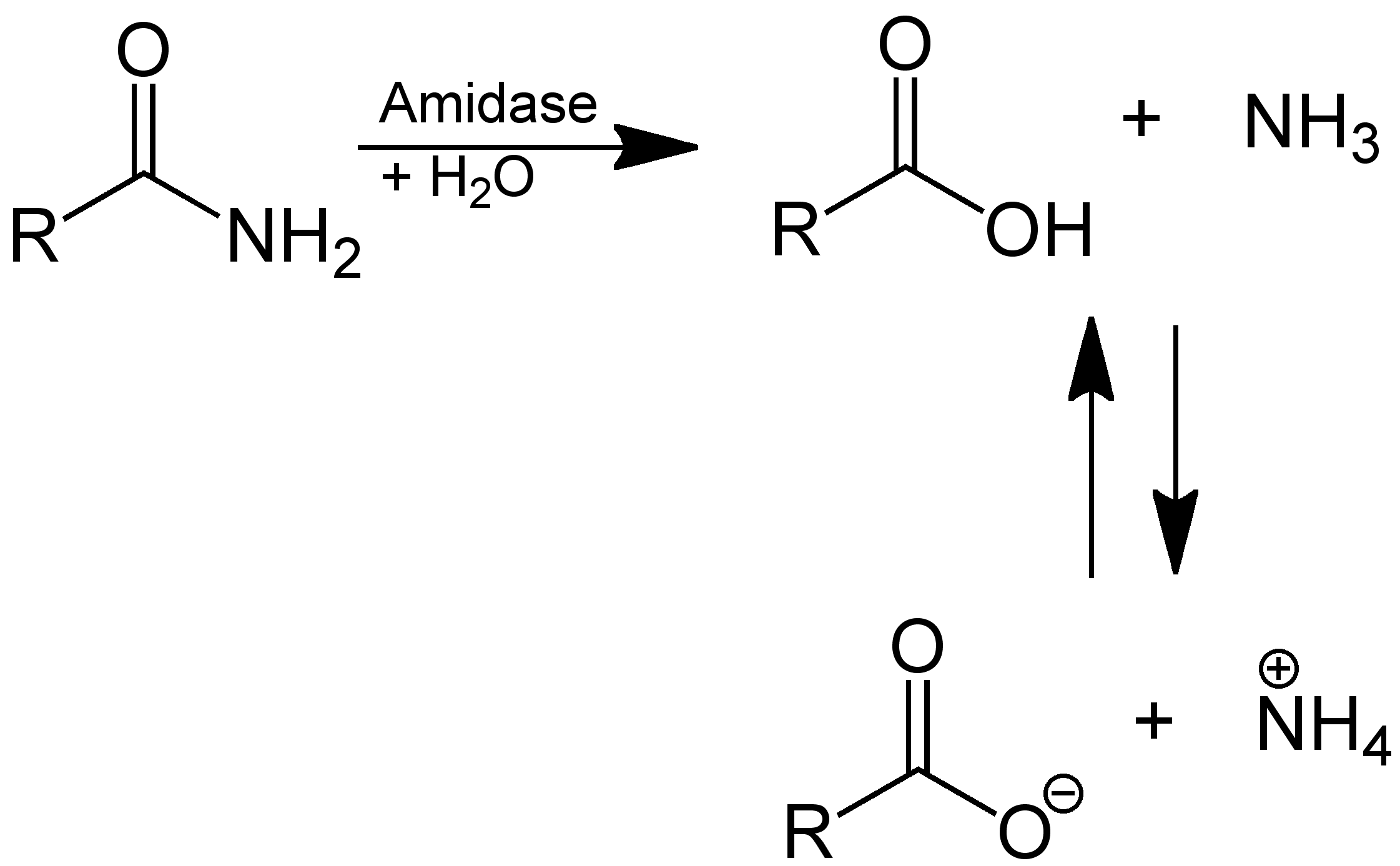|
Trypanothione Synthase
In enzymology, a trypanothione synthase () is an enzyme that catalyzes the chemical reaction :glutathione + glutathionylspermidine + ATP \rightleftharpoons N1,N8-bis(glutathionyl)spermidine + ADP + phosphate The 3 substrates of this enzyme are glutathione, glutathionylspermidine, and ATP, whereas its 3 products are N1,N8-bis(glutathionyl)spermidine, ADP, and phosphate. This reaction is especially important for protozoa in the order kinetoplastida as the molecule of N1,N8-bis(glutathionyl)spermidine, also known as trypanothione, is homologous to the function of glutathione in most other prokaryotic and eukaryotic cells. This means that it is a key intermediate in maintaining thiol redox within the cell and defending against harmful oxidative effects in such protozoa. This enzyme belongs to the family of ligases, specifically those forming carbon-nitrogen bonds as acid-D-ammonia (or amine) ligases (amide synthases). The systematic name of this enzyme class is glutathionylsp ... [...More Info...] [...Related Items...] OR: [Wikipedia] [Google] [Baidu] |
Enzymology
An enzyme () is a protein that acts as a biological catalyst by accelerating chemical reactions. The molecules upon which enzymes may act are called substrate (chemistry), substrates, and the enzyme converts the substrates into different molecules known as product (chemistry), products. Almost all metabolism, metabolic processes in the cell (biology), cell need enzyme catalysis in order to occur at rates fast enough to sustain life. Metabolic pathways depend upon enzymes to catalyze individual steps. The study of enzymes is called ''enzymology'' and the field of pseudoenzyme, pseudoenzyme analysis recognizes that during evolution, some enzymes have lost the ability to carry out biological catalysis, which is often reflected in their amino acid sequences and unusual 'pseudocatalytic' properties. Enzymes are known to catalyze more than 5,000 biochemical reaction types. Other biocatalysts include Ribozyme, catalytic RNA molecules, also called ribozymes. They are sometimes descr ... [...More Info...] [...Related Items...] OR: [Wikipedia] [Google] [Baidu] |
List Of Enzymes
Enzymes are listed here by their classification in the International Union of Biochemistry and Molecular Biology's Enzyme Commission (EC) numbering system: :Oxidoreductases (EC 1) ( Oxidoreductase) * Dehydrogenase * Luciferase * DMSO reductase :EC 1.1 (act on the CH-OH group of donors) * :EC 1.1.1 (with NAD+ or NADP+ as acceptor) ** Alcohol dehydrogenase (NAD) ** Alcohol dehydrogenase (NADP) ** Homoserine dehydrogenase ** Aminopropanol oxidoreductase ** Diacetyl reductase ** Glycerol dehydrogenase ** Propanediol-phosphate dehydrogenase ** glycerol-3-phoshitiendopene dehydrogenase (NAD+) ** D-xylulose reductase ** L-xylulose reductase ** Lactate dehydrogenase ** Malate dehydrogenase ** Isocitrate dehydrogenase ** HMG-CoA reductase * :EC 1.1.2 (with a cytochrome as acceptor) * :EC 1.1.3 (with oxygen as acceptor) ** Glucose oxidase ** L-gulonolactone oxidase ** Thiamine oxidase ** Xanthine oxidase * EC 1.1.4 (with a disulfide as accep ... [...More Info...] [...Related Items...] OR: [Wikipedia] [Google] [Baidu] |
Chagas Disease
Chagas disease, also known as American trypanosomiasis, is a tropical parasitic disease caused by ''Trypanosoma cruzi''. It is spread mostly by insects in the subfamily Triatominae, known as "kissing bugs". The symptoms change throughout the infection. In the early stage, symptoms are typically either not present or mild and may include fever, swollen lymph nodes, headaches, or swelling at the site of the bite. After four to eight weeks, untreated individuals enter the chronic phase of disease, which in most cases does not result in further symptoms. Up to 45% of people with chronic infections develop heart disease 10–30 years after the initial illness, which can lead to heart failure. Digestive complications, including an enlarged esophagus or an enlarged colon, may also occur in up to 21% of people, and up to 10% of people may experience nerve damage. is commonly spread to humans and other mammals by the kissing bug's bite wound and the bug's infected feces. The disea ... [...More Info...] [...Related Items...] OR: [Wikipedia] [Google] [Baidu] |
Nagana
Animal trypanosomiasis, also known as nagana and nagana pest, or sleeping sickness, is a disease of non-human vertebrates. The disease is caused by trypanosomes of several species in the genus ''Trypanosoma'' such as '' T. brucei'' (which also infects humans to cause African Sleeping Sickness), and '' T. vivax'' which causes nagana in livestock mainly in West Africa, although it has also spread to South America. The trypanosomes infect the blood of the vertebrate host, causing fever, weakness, and lethargy, which lead to weight loss and anemia. In some animals, the disease is fatal if not treated. The trypanosomes are transmitted by tsetse flies. An interesting feature is the remarkable tolerance to nagana pathology shown by some breeds of cattle, notably the N'Dama – a West African ''Bos taurus'' breed. This contrasts with the susceptibility shown by East African '' B. indicus'' cattle such as the zebu. Transmission Most trypanosomes develop in tsetse flies ('' Glossina'' ... [...More Info...] [...Related Items...] OR: [Wikipedia] [Google] [Baidu] |
Human African Trypanosomiasis
African trypanosomiasis is an insect-borne parasitic infection of humans and other animals. Human African trypanosomiasis (HAT), also known as African sleeping sickness or simply sleeping sickness, is caused by the species ''Trypanosoma brucei''. Humans are infected by two types, ''Trypanosoma brucei gambiense'' (TbG) and ''Trypanosoma brucei rhodesiense'' (TbR). TbG causes over 92% of reported cases. Both are usually transmitted by the bite of an infected tsetse fly and are most common in rural areas. Initially, the first stage of the disease is characterized by fevers, headaches, itchiness, and joint pains, beginning one to three weeks after the bite. Weeks to months later, the second stage begins with confusion, poor coordination, numbness, and trouble sleeping. Diagnosis involves detecting the parasite in a blood smear or lymph node fluid. A lumbar puncture is often needed to tell the difference between first- and second-stage disease. Prevention of severe disease i ... [...More Info...] [...Related Items...] OR: [Wikipedia] [Google] [Baidu] |
Trypanosoma Brucei
''Trypanosoma brucei'' is a species of parasitic Kinetoplastida, kinetoplastid belonging to the genus ''Trypanosoma'' that is present in sub-Saharan Africa. Unlike other protozoan parasites that normally infect blood and tissue cells, it is exclusively extracellular and inhabits the blood plasma and body fluids. It causes deadly vector-borne diseases: African trypanosomiasis or sleeping sickness in humans, and animal trypanosomiasis or ''nagana'' in cattle and horses. It is a species complex grouped into three subspecies: ''T. b. brucei'', ''T. b. gambiense'' and ''T. b. rhodesiense''. The first is a parasite of non-human mammals and causes ''nagana'', while the latter two are zoonotic infecting both humans and animals and cause African trypanosomiasis. ''T. brucei'' is transmitted between mammal hosts by an insect Vector (epidemiology), vector belonging to different species of tsetse fly (''Glossina''). Transmission occurs by biting during the insect's blood meal. The parasites ... [...More Info...] [...Related Items...] OR: [Wikipedia] [Google] [Baidu] |
Trypanosoma Cruzi
''Trypanosoma cruzi'' is a species of parasitic euglenoids. Among the protozoa, the trypanosomes characteristically bore tissue in another organism and feed on blood (primarily) and also lymph. This behaviour causes disease or the likelihood of disease that varies with the organism: Chagas disease in humans, dourine and surra in horses, and a brucellosis-like disease in cattle. Parasites need a host body and the haematophagous insect triatomine (descriptions "assassin bug", "cone-nose bug", and "kissing bug") is the major vector in accord with a mechanism of infection. The triatomine likes the nests of vertebrate animals for shelter, where it bites and sucks blood for food. Individual triatomines infected with protozoa from other contact with animals transmit trypanosomes when the triatomine deposits its faeces on the host's skin surface while blood feeding. Penetration of the infected faeces is further facilitated by the scratching of the bite area by the human or animal h ... [...More Info...] [...Related Items...] OR: [Wikipedia] [Google] [Baidu] |
Spermidine
Spermidine is a polyamine compound () found in ribosomes and living tissues and having various metabolic functions within organisms. Function Spermidine is an Aliphatic compound, aliphatic polyamine. Spermidine synthase (SPDS) catalyzes its formation from putrescine. It is a precursor to other polyamines, such as spermine and its structural isomer polyamine#thermospermine, thermospermine. Spermidine synchronizes an array of biological processes, (such as Ca2+, Na+, K+ -ATPase) thus maintaining membrane potential and controlling intracellular pH and volume. Spermidine regulates biological processes, such as Ca2+ influx by glutamatergic N-Methyl-D-aspartic acid, ''N''-methyl-D-aspartate receptor (NMDA receptor), which has been associated with nitric oxide synthase (NOS) and cGMP/PKG pathway activation and a decrease of Na+,K+-ATPase activity in cerebral cortex synaptosomes. Spermidine is a longevity agent in mammals due to various mechanisms of action, which are just beginning to ... [...More Info...] [...Related Items...] OR: [Wikipedia] [Google] [Baidu] |
Reaction Figure
Reaction may refer to a process or to a response to an action, event, or exposure. Physics and chemistry *Chemical reaction *Nuclear reaction *Reaction (physics), as defined by Newton's third law * Chain reaction (other) Biology and medicine *Adverse drug reaction *Allergic reaction *Reflex, neural reaction *Hypersensitivity, immune reaction *Intolerance (other) * Light reaction (other) Psychology *Emotional, reaction * Reactivity *Proactivity, opposite of reactive behaviour *Reactive attachment disorder Politics and culture *Reactionary, a political tendency *Reaction video *Commentary (other) Proper names and titles * ''Reaction'' (album), a 1986 album by American R&B singer Rebbie Jackson ** "Reaction" (song), the title song from the Rebbie Jackson album *"Reaction", a single by Dead Letter Circus *''Reactions'', a 2018 album by The Mods *ReAction GUI, a GUI toolkit used on AmigaOS * Reaction.life, a political news and commentary web ... [...More Info...] [...Related Items...] OR: [Wikipedia] [Google] [Baidu] |
Amidase
In enzymology, an amidase (, ''acylamidase'', ''acylase (misleading)'', ''amidohydrolase (ambiguous)'', ''deaminase (ambiguous)'', ''fatty acylamidase'', ''N-acetylaminohydrolase (ambiguous)'') is an enzyme that catalysis, catalyzes the hydrolysis of an amide. In this way, the two substrate (biochemistry), substrates of this enzyme are an amide and water, H2O, whereas its two product (chemistry), products are monocarboxylate and ammonia, NH3. This enzyme belongs to the family of hydrolases, those acting on carbon-nitrogen bonds other than peptide bonds, specifically in linear amides. The List of enzymes, systematic name of this enzyme class is acylamide amidohydrolase. Other names in common use include acylamidase, acylase, amidohydrolase, deaminase, fatty acylamidase, and N-acetylaminohydrolase. This enzyme participates in 6 metabolism, metabolic pathways: urea cycle and metabolism of amino groups, phenylalanine metabolism, tryptophan metabolism, cyanoamino acid metabolism, b ... [...More Info...] [...Related Items...] OR: [Wikipedia] [Google] [Baidu] |
Aminohydrolase
An aminohydrolase is a hydrolase enzyme which acts upon an amino In chemistry, amines (, ) are organic compounds that contain carbon-nitrogen bonds. Amines are formed when one or more hydrogen atoms in ammonia are replaced by alkyl or aryl groups. The nitrogen atom in an amine possesses a lone pair of elec ... group. Aminohydrolases are classified under EC number EC 3.5.4. External links * EC 3.5 {{3.5-enzyme-stub ... [...More Info...] [...Related Items...] OR: [Wikipedia] [Google] [Baidu] |
Histidine
Histidine (symbol His or H) is an essential amino acid that is used in the biosynthesis of proteins. It contains an Amine, α-amino group (which is in the protonated –NH3+ form under Physiological condition, biological conditions), a carboxylic acid group (which is in the deprotonated –COO− form under biological conditions), and an imidazole side chain (which is partially protonated), classifying it as a positively charged amino acid at physiological pH. Initially thought essential amino acid, essential only for infants, it has now been shown in longer-term studies to be essential for adults also. It is Genetic code, encoded by the Genetic code, codons CAU and CAC. Histidine was first isolated by Albrecht Kossel and Sven Gustaf Hedin in 1896. The name stems from its discovery in tissue, from ''histós'' "tissue". It is also a Precursor (chemistry), precursor to histamine, a vital inflammatory agent in immune responses. The acyl radical (chemistry), radical is histidyl. Pro ... [...More Info...] [...Related Items...] OR: [Wikipedia] [Google] [Baidu] |





